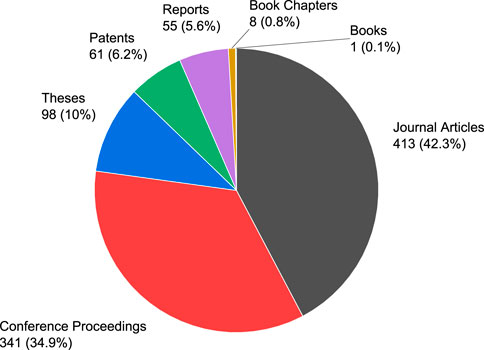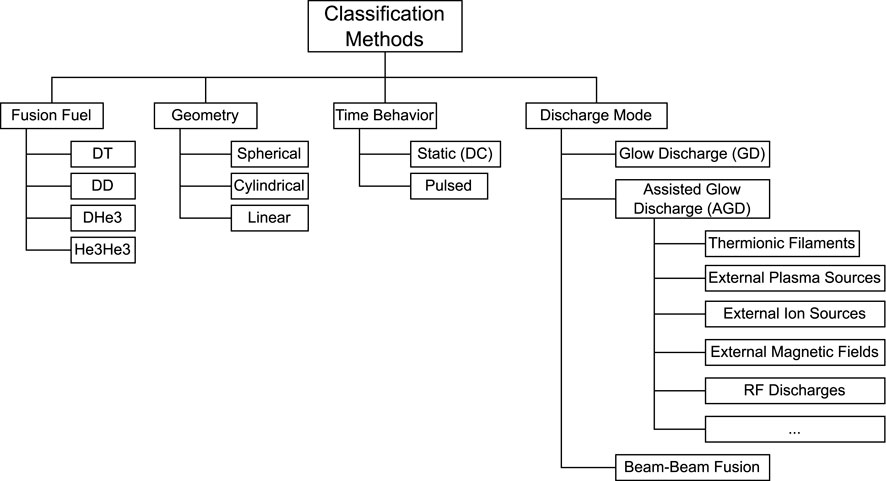- 1Institute of Aerospace Engineering, TUD Dresden University of Technology, Dresden, Germany
- 2Interface Analysis Center, School of Physics, University of Bristol, Bristol, United Kingdom
- 3Astral Systems, Bristol, United Kingdom
- 4Physics Department, Faculty of Science, Assiut University, Assiut, Egypt
- 5Faculty of Space Technologies, AGH University of Krakow, Kraków, Poland
Inertial electrostatic confinement fusion has developed into a widespread academic field since its inception in the 1950s and 1960s. This paper provides an overview of the different research groups (universities and research institutes) and companies involved in the field of IECF and their scientific publications. A list of over 970 publications from 56 universities, 20 research institutes, and 25 companies was collected and analyzed. Also, an overview of the most common type of IECF devices, often referred to as “gridded” IECF device or “fusor” was created, including more than 30 devices. This paper serves as both a reference guide to the literature and the IECF devices.
1 Introduction
Inertial Electrostatic Confinement Fusion (IECF) is a well-established concept to electrostatically confine and accelerate ions to create conditions suitable for nuclear fusion reactions. Since its inception in the 1950s and 1960s (Hirsch, 1967), various methods and experiments have been devised to realize its potential. The confinement of the ions is achieved by either using physical electrodes consisting of cathodes nested inside anodes (commonly known as fusor-type devices) or by imploring a negative space charge from electron clouds, with the Polywell being the most promising concept. An overview of these different types of IEC devices is presented in Figure 1. However, fundamental limitations and inherent loss mechanisms of the concept were recognized early, making scaling toward a power reactor unlikely. Nonetheless, extensive research activities have been performed in the field of IECF, ranging from analyzing the physical principles and scaling laws to fusion experiments with demonstrators. Additionally, numerous applications have been proposed utilizing IECF devices as neutron sources or for non-fusion applications, such as space thrusters (see Figure 2). Summaries of the near-term applications are provided in (Kulcinski and Santarius, 2013; Kulcinski et al., 2009), and in Chapter 12 of (Miley and Murali, 2014).
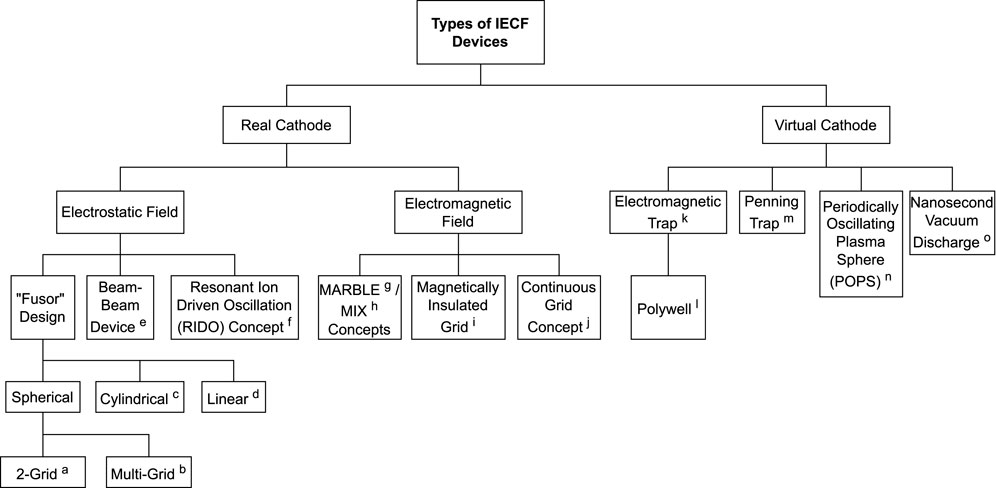
Figure 1. Overview of concepts for fusion devices based on the field of IECF (a: Fancher, 2018; Bakr et al., 2021; b: Dietrich, 2007; McGuire and Sedwick, 2008; c: Tomiyasu et al., 2009; Bhattacharjee et al., 2021; d: Miley and Sved, 1997; Itagaki et al., 2021; Watanabe et al., 2019; e: Hirsch, 1967; Egle, 2010; f: Jurczyk et al., 1997; g: Knapp, 2015; h: Klein, 2011; i: Hedditch et al., 2015; j: Chap, 2017; k: Dolan, 1994; l: Park et al., 2015; Poznic et al., 2019; m: Barnes et al., 2000; n: Park et al., 2005a; o: V Oginov et al., 2019)).
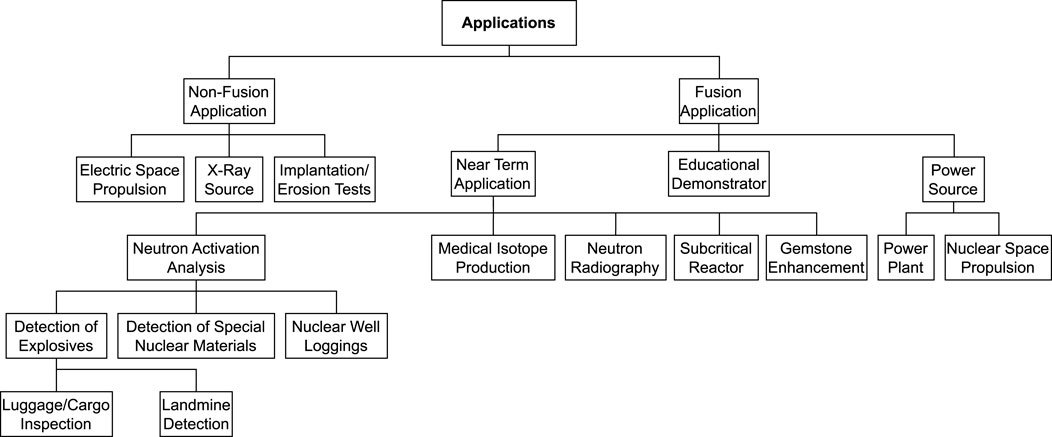
Figure 2. Overview of different proposed applications for the IEC technology (collected from (Kulcinski and Santarius, 2013; Yoshikawa et al., 2007; Kulcinski, 1996; Kulcinski et al., 2017)). Note that most of these applications have been proposed or only demonstrated under laboratory conditions.
The most widely used type of IECF device relies on two spherical concentric electrodes (“grids”) and is also often referred to as “fusor”. Its basic layout is shown in Figure 3. Ions from a glow discharge plasma are easily accelerated to fusion-relevant energies (15 to over 100 keV), but particle collisions with the electrodes, a low ionization rate, and the lack of electron confinement limit the overall efficiency of such devices (Miley and Murali, 2014).
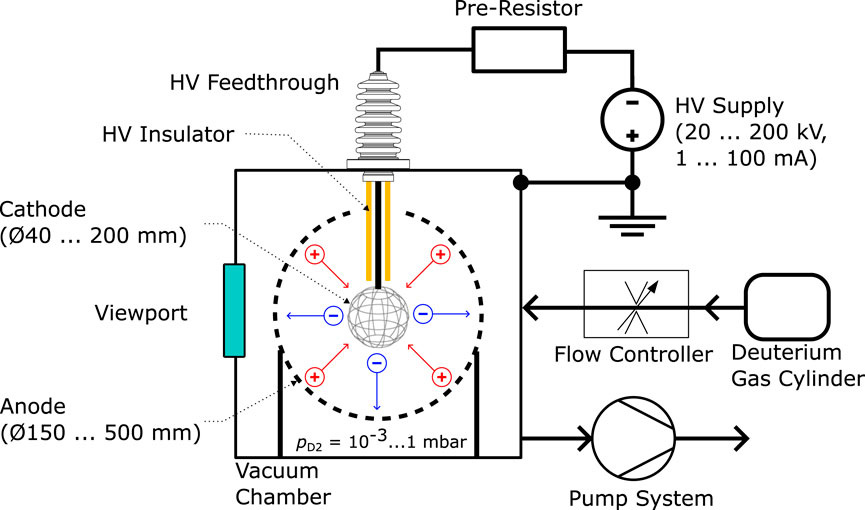
Figure 3. Outline of a typical gridded IECF device with a spherical cathode and anode grid for continuous glow discharge operation (from (Wulfkühler et al., 2024)).
Due to its simplicity and low cost for demonstrators, the research in the field has been driven mostly by universities and some research institutes. However, several companies have also been involved. The field of IECF has been relatively isolated from other fields of nuclear fusion development, like magnetic confinement fusion (e.g., the development of the tokamak or stellarator design) and inertial confinement fusion (e.g., laser-fusion). Although the research field of IECF is relatively small, the contributions of many research groups over a time span of more than 60 years make it difficult to keep an overview of all the activities. Also, as will be shown in this analysis, nearly 60% of the universities and 45% of the research institutes have commenced their activities within the last 15 years.
The centerpiece of this work was the creation of a literature dataset including as many publications from the field of IECF as possible between 1959 and April 2023. Based on this, the main aims of this publication are to:
1. Provide an overview of institutions (universities, research institutes, and companies) that are currently or were previously affiliated with the field of IECF. In 2013, a less detailed overview of the involved institutions was given in (Kulcinski and Santarius, 2013).
2. Provide an overview of available publications (Peer-reviewed papers, conference proceedings, academic theses, and patents) by each institution from 1959 to April 2023. This overview consists of a) a bibliography data set (which is available online as Supplementary Material) and b) a table (Supplementary Table A.2) that associates each publication with one or two keywords.
3. Derive main statistics and information from the literature data set (including a world map with all institutions, diagrams that detail the composition of the data set by a) document type, b) type and publication year, c) overview of main journals, and d) co-authorship analysis). Also, a brief overview of the US-Japan Workshop is given.
4. Provide an overview of gridded and beam-beam IECF devices with proven fusion records, including neutron production rate (NPR), power consumption, and geometry. A comparison of NPR levels and NPR/kW is conducted. (The complete overview is given in Supplementary Table B.1).
5. Present a novel approach to analyzing a research field that deviates from classical reviews, meta-analyses, or bibliometric studies (Donthu et al., 2021).
For an extended review of the field of IECF, the work by Miley and Murali (2014) provides a comprehensive and detailed overview. Additional historical background is available in Miley (2013).
The remainder of the paper is organized as follows: Section 2 gives an overview of the different institutions affiliated with the IECF technology. The methodology behind this analysis is outlined in Section 3. Following this, Section 4 presents an overview of IECF devices (gridded and beam-beam) with a proven fusion record from one of the following fusion fuels: deuterium-tritium (DT), deuterium-deuterium (DD), deuterium-helium-3 (DHe3), or helium-3-helium-3 (He3He3). The paper concludes with an outlook and a summary.
2 Overview of research groups
As the centerpiece of this study, a dataset with literature from the field of IECF was created. An overview of the contents of this set is given in Supplementary Appendix A in the form of an extended table, which should be consulted while reading this paragraph. The exact methodology for creating this dataset is described in Section 3. The set contains journal publications, conference proceedings, theses (of Bachelor, Master, and Ph.D. level), and patents. Academic theses were included since the field of IECF has been driven by university-level research, and some of the work has not been published elsewhere. Patents were included in the dataset for the following reasons: In the scope and approach of this paper, patents represent an important means of identifying companies affiliated with IECF technology. Also, potential commercial applications of IECF have always played an important role and have been a driver of the research field. Among the first publications on IECF in the late 1960s are several patents filed by Farnsworth (1966), Farnsworth (1968), Hirsch (1970a), Hirsch and Meeks (1970), Hirsch (1970b); Hirsch (1972a), Hirsch (1972b). The final dataset contains over 950 entries.
Figure 4 illustrates the composition of this dataset. Journal articles and conference proceedings account for over 75% of the sources, while academic theses make up 10%. There are only eight book chapters on IECF, along with a single book solely dedicated to IECF. These publications were associated with 101 different institutions (56 universities, 20 research institutes, and 25 companies). An institution had to be affiliated with the lead author of a publication to be considered associated. Figure 5 offers a geographic overview of the locations of all institutions.
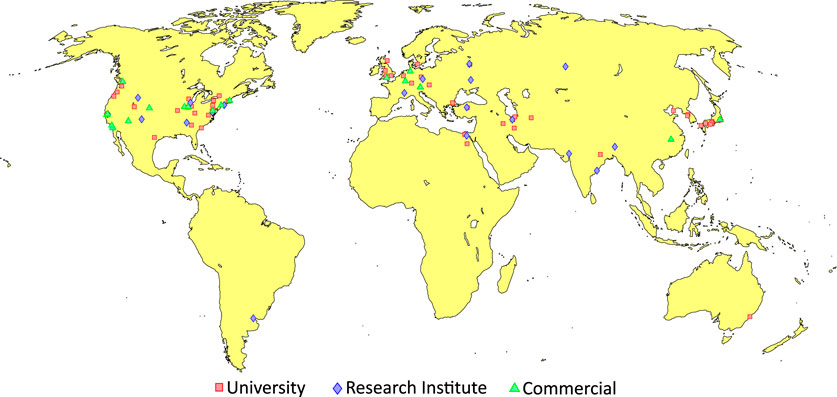
Figure 5. Map with locations of affiliates within the field of IECF (please use the zoom function in the online PDF for a precise view).
A visualization of the publications per type and year is shown in Figure 6. The first publication in the field can be attributed to Elmore et al., in 1959: “On the Inertial-Electrostatic Confinement of a Plasma” (Elmore et al., 1959). In 1966, Farnsworth published the first patent, which sparked subsequent activities (Farnsworth, 1966). Further patents were published by Farnsworth, Hirsch et al., and Hirsch built and tested the first prototypes for IECF devices, which were also tested at Brigham Young University (Gardner et al., 1975; Gardner, 1976) with parallel investigations of the IECF concept at the University of Illinois (Verdeyen et al., 1975; Cherrington et al., 1975). There was only limited activity in the 1980s. Since the early 1990s, the activity in the field gradually increased with new efforts by Miley et al. at the University of Illinois (Miley and Sved, 1997; Miley et al., 1994), the Los Alamos National Laboratory (Nebel et al., 1995; Park et al., 2005b), and with the Energy/Matter Conversion Corporation (EMC2), a focus was set on the Polywell design with potential commercial applications in the energy market (Bussard, 1991; Bussard, 2006). The network in the US expanded greatly with work conducted at the University of Wisconsin-Madison (Thorson et al., 1997; Kulcinski et al., 2015), and subsequent cooperation with the University of Kyoto (Ohnishi et al., 1995) and the Tokyo Institute of Technology (Yamauchi et al., 2001). Not all of the listed universities, institutes, and companies are active anymore in the field of IECF. Also, several of the companies no longer exist. However, the status of activity can, of course, also change in the future. Therefore, the years of the first and the latest publication are provided in Supplementary Table A.2 and can be understood as a rough indicator of the current activity level. It should also be considered that institutes might have continued publishing as co-authors. Additionally, as evident from the column containing the first year of a publication, the 2010s witnessed a surge of new activities from various universities (IDs: U22 to U56) and research institutes (R12 to R20).
Two measures were taken to assess the activities of the individual institutions. First, as shown in Supplementary Table A.2, the activities of the institutions were categorized as follows: a) purely theoretical contributions in the field of IECF, b) non-fusion experimental work, and c) actual fusion experiments. Of the 101 institutions, 45 fall into the first category, 17 into the second one, and 39 into the last one. As a second measure, each publication was manually associated with at least one of about 150 keywords from 12 different categories listed in Supplementary Table A.1. Although this simple classification cannot provide a detailed analysis of every activity performed by an institution, it can offer a quick overview of the general activities carried out at a particular institution.
A co-authorship analysis was conducted using the bibliometrix tool to understand the interconnectedness of the research groups (Aria and Cuccurullo, 2017). Figure 7 shows the connection between the top 300 authors (out of more than 900 authors in total). An overlay was created to visualize the 33 different affiliations of the authors roughly. As shown, the University of Illinois (U3) is well-connected with the Los Alamos National Laboratory (R1) and the Company EMC2 (C4). Connections extend to the University of Wisconsin-Madison and Kyoto University, which is affiliated with Kansai University and Tokyo Institute of Technology, as well as loosely to the University of Sydney (U13). Figure 7 also reflects the temporal evolution: A subgroup (at the lower right side) of the University of Illinois (U3) is not connected to the rest. This disconnect arises from the fact that Verdeyen, Dolan, Cherrington et al. conducted experiments in the 1970s (Dolan et al., 1972; Meeker et al., 1973; Swanson et al., 1973), while Miley et al. began their work on IECF in the late 1980s (Miley, 2013). Other research groups have not published with these strongly connected groups.
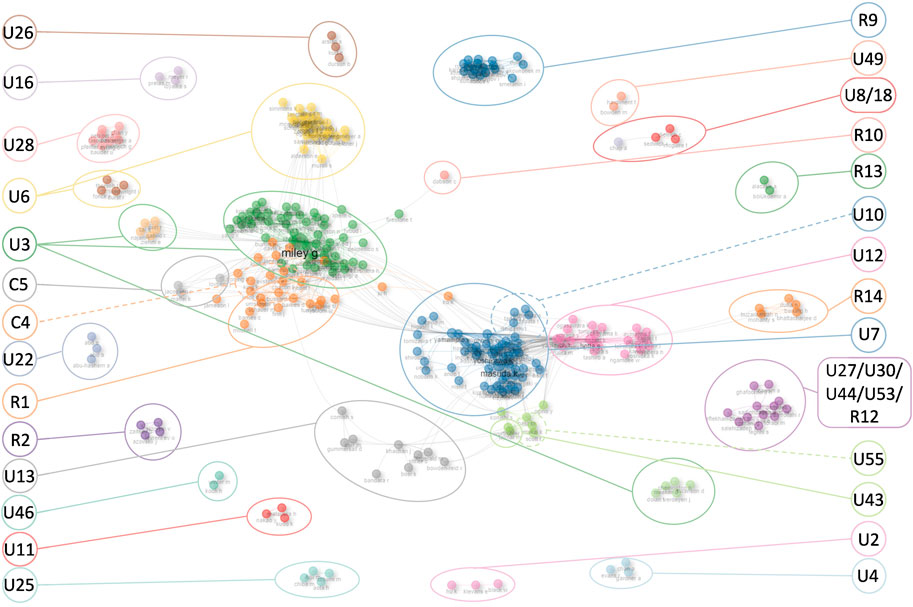
Figure 7. Co-authorship analysis of top 300 authors and their respective affiliations (created with bibliometrix (Aria and Cuccurullo, 2017), please use the zoom function in the online version for a precise view of the names). The abbreviations correspond to the indices listed in Supplementary Table A.2 in Supplementary Appendix A.
One explanation for the interconnection between the US, Japanese, and Australian institutions is the US-Japan workshop on IECF, which took place regularly between 1998 and 2019. Miley (Miley, 2013) gives some details about the US-Japan Workshop. Unfortunately, the publications for the US-Japan Workshop are mainly in the form of PowerPoint presentations and are not centrally collected or accessible. Still, presentations from the workshop have been referenced in the scientific literature (for example, at least 17 times in (Miley and Murali, 2014)). Supplementary Appendix D contains an Excel file with a list of all past events and includes the titles of all presentations from the 21 conferences. The data was compiled from several conference websites and by directly contacting former participants.
Although not included in the overview of Supplementary Table A.1, the work of the amateur scientist community in the field of IECF is worth mentioning here. These hobbyists, many of whom have shared their work in the online forum fusor.net since 1998, have built numerous IECF devices with a proven fusion record (Fusor, 2025). The website maintains a list of “Fusioneers”, which includes people and institutions (such as high schools, and student groups of colleges and universities) that have achieved nuclear fusion using IECF devices, typically through a deuterium gas discharge with gridded devices (Hull, 2025). Based on a review of scientific publications, no direct influence of the amateur community on the scientific community could be determined.
3 Methodology
A sketch of the multi-step process that was conducted to create and analyze a dataset of publications in the field of IECF is given in Figure 8. Data was collected from five different sources and then combined within a reference management software for subsequent export and analysis. The reference management software had to meet several criteria: a) Exportability in. csv format, b) support of custom data fields (to add keywords, affiliations, etc.), c) support of custom BibTeX keys, and d) a low loss rate during the import of files from Scopus and Web of Science. The following reference management software packages were evaluated: Mendeley, JabRef, Zotero, EndNote, and Citavi. Only Citavi met all the requirements. The first step was to obtain data sets with publications from Scopus and Web of Science. The search string “inertial electrostatic confinement fusion” or “inertial electrostatic confinement” or polywell (access date: 23rd January 2023) was used. Merging these two datasets into a single coherent dataset without duplicates presented several challenges, as both datasets use different fields and formats. Duplicates were removed with the help of Citavi’s internal tool based on the Levenshtein algorithm, while Scopus files were prioritized over Web of Science files. Patents in the field of IEC were identified with The Lens platform through the search string “inertial electrostatic confinement” (access date: 31st April 2023) and added to Citavi. The bibliography of Dietrich’s dissertation (Dietrich, 2007) contained a large dataset with 304 sources up to the year 2005, many of which (especially conference proceedings of the Bulletin of Physics) are not identified through Scopus, Web of Science, or Google Scholar. These missing entries were added manually to the dataset in Citavi. Keywords were added in Citavi as a custom field. Finally, several research groups were contacted to check for missing entries. Using Citavi’s table view function, the data set was exported to Excel and analyzed with a Python script that utilized the pandas library (T. pandas development team, 2020) to automatically create the entries in Supplementary Table A.2. An abridged version of the table was used to create the co-authorship plot in Figure 7 with the bibliometrix package in the R software environment (specifically the biblioshiny browser interface) (Aria and Cuccurullo, 2017). Furthermore, BibTeX and RIS files were exported from Citavi.
The methodology described here grew “organically” from the initial desire to present an overview of the scientific output produced by the IECF community and to identify the institutions involved. Supplementary Table A.2 evolved as the centerpiece of the analysis. Certain basic methods from the field of bibliometrics were borrowed to analyze the dataset, including the types of work (Figure 4), annual citation frequency (Figure 6), and a co-authorship analysis (Figure 7). More advanced methods, such as co-citation analysis, co-word analysis, or focusing on metrics like the h-index, were avoided because the dataset does not contain all the necessary information, including individual citations, and the assigned keywords are subjective and should not be used. An overview of the tools available for a comprehensive bibliometric analysis is provided in (Donthu et al., 2021).
Although the dataset was compiled from multiple sources, several limitations remain, and potential biases should be acknowledged:
• Only publications in the English language were considered. While most publications are assumed to be in English, technical reports and theses are often written in other languages.
• Only some universities practice the publication of theses of their students. Additionally, these theses are usually published through university platforms and are often difficult to access.
• Other gray literature, such as technical reports, has only been published by some research groups.
• Because only the institutions of the primary authors have been included, some institutions that have been active in the research field might not appear in Supplementary Table A.2.
• Of the 101 institutions, only 62 have produced more than one publication. Only 74 of the institutes have published a peer-reviewed paper, and just 41 have at least two journal publications. This leads to the inclusion of many small research groups.
• Especially conference proceedings from before the year 2000 are difficult to access. Furthermore, even if they are listed in a database, it remains unclear whether they constitute a complete text or merely an abstract.
• For the creation of the manual dataset, the email questionnaire was mainly responded to by research groups that had been active in the last 10 years. Therefore, historically significant but currently inactive institutions might be underrepresented.
Similarly, the keywording process is prone to some limitations and potential biases:
• Single keyword assignment: Some publications were only assigned one keyword, which may oversimplify their content, especially in multi-topic studies.
• Generic classification of patents and reports: Patents and some reports were often solely classified by the type of document.
• In several cases, the documents were not accessible (primarily technical reports and conference proceedings) and had to be classified based on the title or document type. This may, in some instances, not accurately reflect the actual content of the publications.
Therefore, the keywords can aid the process of identifying relevant literature for a specific topic, but cannot replace an in-depth search.
4 Overview of gridded IECF devices
As mentioned in the introduction and illustrated in Figure 1, many different approaches have been explored to realize the concept of IECF. As stated in the previous section, nearly 40% of the 101 institutions listed in Supplementary Table A.2 have conducted nuclear fusion experiments with IEC technology. Among the actually built experiments, the most common and simple ones are “gridded” devices (because they use grid-shaped transparent electrodes to create the electrostatic field). The book by Miley and Murali (Miley and Murali, 2014) can be consulted for an overview of the performance of other IECF technologies, including the Polywell (U13, C4), Spherical Oscillating Plasma Sphere devices (R1), and Penning Trap Fusion devices (R1). However, these advanced concepts have only been studied by a small number of institutions and, based on the limited number of publications in recent years, progress appears to be stagnant.
Brief summaries of the performance of the gridded devices have already been provided in (Kulcinski and Santarius, 2013; Miley and Murali, 2014; Hermans, 2013). However, a comprehensive overview is absent from the literature. Therefore, Supplementary Table A.2 was created as a quick reference guide, which contains the main parameters of 36 different devices from 21 institutions operated in 44 different configurations.
The aim was to summarize the latest performance data from the gridded devices by these 21 research groups. It should be noted that not all apparatuses are necessarily active anymore. Given that many of these devices, like the “HOMER” facility at the University of Wisconsin-Madison, underwent years of continuous optimization (e.g., by expanding the maximum operating voltage) (Fancher, 2018; Fusor, 2025; Hull, 2025), the primary focus was only to include the latest device configuration, which also usually achieved the highest fusion rates.
As shown in Figure 9, there are several ways in which gridded IECF technology can be further classified, based on the fusion fuel, electrode geometry, time behavior, and discharge mode. All this information was collected for the devices listed in Supplementary Table B.1. Here, only a brief summary of the developments of gridded IECF devices will be provided, following the structure outlined in Figure 9 and by comparing the neutron production rates of the devices as a key performance metric. The references in Supplementary Appendix B can be consulted for more detailed information on individual apparatuses.
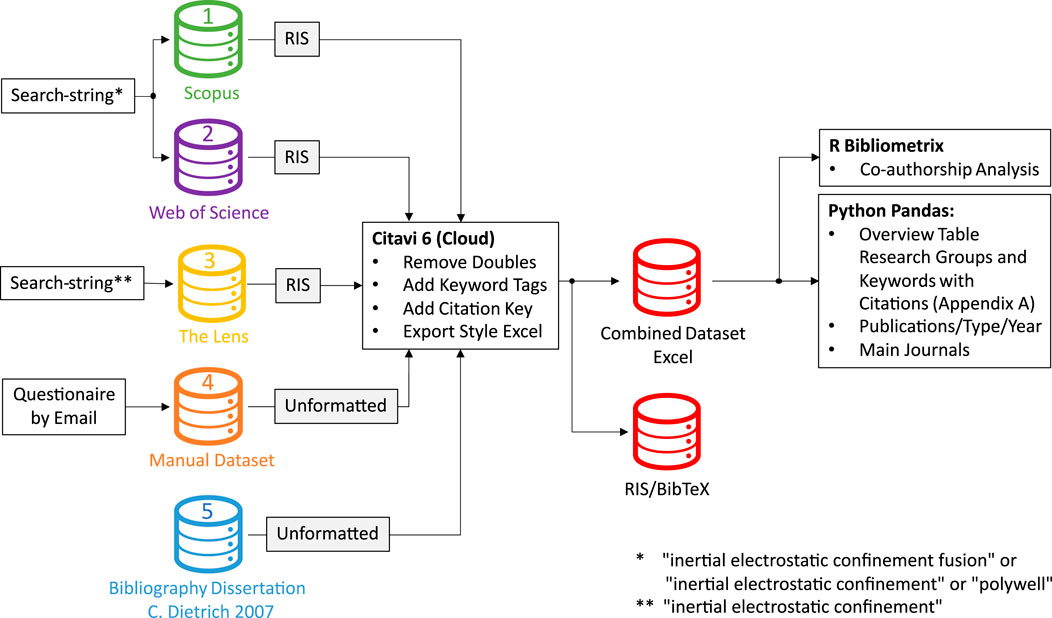
Figure 9. Different methods to classify the gridded IECF Devices of Supplementary Table B.1.
In terms of fusion fuel, only two of the devices (Hirsch, 1967; Ohnishi et al., 2016) have been operated with a deuterium-tritium fusion mixture due to the necessary safety precautions and high costs involved in handling the radioactive tritium. The operation with the DHe3 reaction was tested at the University of Wisconsin-Madison (Cipiti, 2004; Egle and Kulcinski, 2009) and the University of Kyoto (Masuda et al., 2005; Masuda et al., 2006; Fujimoto et al., 2007), as it is of high interest for medical isotope production. The University of Wisconsin-Madison also analyzed the He3He3 reaction (Piefer, 2006). Although this has been the goal of some development, the aneutronic pB11 fusion reaction has not been demonstrated with an IECF device (Miley and Murali, 2014).
Based on the geometry of the electrodes, the devices can be distinguished into three categories: spherical, cylindrical, and linear. The majority of devices rely on a spherical geometry, which provides the highest fusion rate. Cylindrical geometries–only used in seven of the experiments listed in Supplementary Table B.1 – can offer more control over the direction of the flux for practical application. Only three experiments used a linear layout.
As shown in Figure 9, ions can be created through different means, including a static or pulsed glow discharge. The discharge may be “assisted” through various techniques, such as external electron sources or applied RF fields, to increase the plasma density. In devices based on this approach, beam-background fusion is usually the dominant fusion mechanism. (Kulcinski et al., 2015; Murali et al., 2006).
To facilitate beam-beam fusion, the focused ion beams from several ion guns might be brought to collision. Only two devices have been built based on this mechanism, including the first IECF experiment by Farnsworth and Hirsch and the Six-Ion-Gun-Fusion-Experiment (SIGFE) (Hirsch, 1967; Egle, 2010).
Figure 10 compares the maximum neutron production rates for different IECF devices, while Figure 11 provides the specific neutron production rate per cathode power. The following devices have achieved the highest neutron production rates:
• Pulsed glow discharge (#20): At the Tokyo Institute of Technology, a record neutron production rate of 7.4·109 n/s was achieved from DD fusion with a pulsed discharge of −80 kV, 15 A peak current, and a pulse length of 20 μs at a repetition rate of 4 Hz.
• Continuous beam-beam device, (#1): Using six focused ion sources operated with a DT mixture, Hirsch obtained 3.9·109 n/s. The acceleration voltage and total current were 150 kV and 10 mA.
• Continuous assisted glow discharge, (#11): Assisted by thermionic filaments, a DD glow discharge at 200 kV and 100 mA produced 3.8·108 n/s.
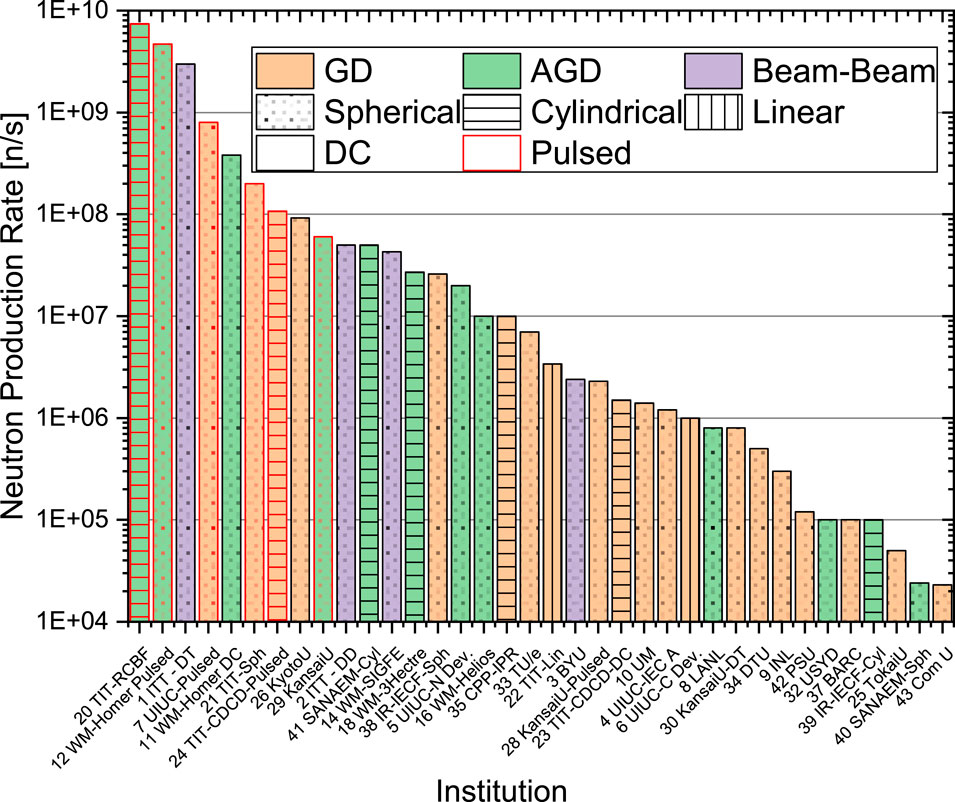
Figure 10. Comparison of neutron production rates from IECF devices in Supplementary Table B.1. The numbers correspond to the configuration number. All tests were conducted with DD fusion, except for configurations 1 and 30, which used a DT mixture as fuel.
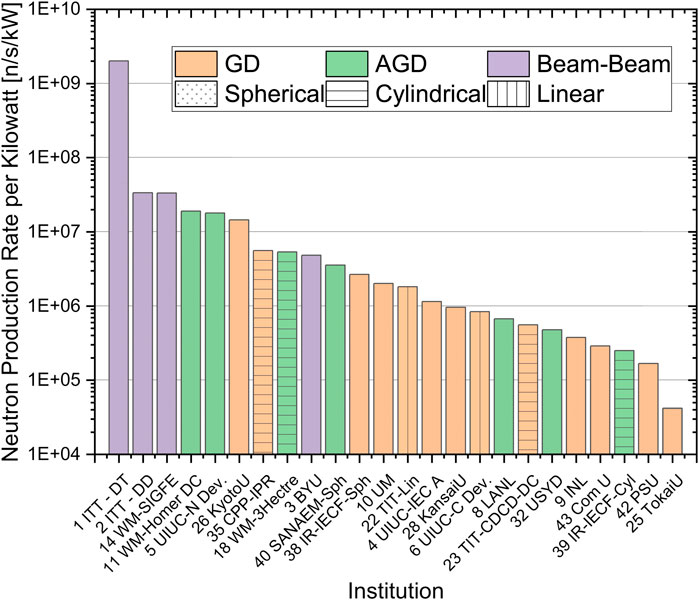
Figure 11. Comparison of neutron production rates from DD fusion reactions per kW of cathode power in IECF devices in Supplementary Table B.1. Only devices with a continuous “DC” discharge were included because there is usually no information on the average of the cathode power consumption for the pulsed devices.
To put these numbers into perspective, it is worth considering that commercial beam target fusion devices, such as those by Adelphi Technology, Inc., achieve neutron rates of 2·1010 n/s (both DD and DT) (Adelphi Technology, 2025). Additionally, for commercial beam-target fusion sources, other equally important factors include neutron flux density, beam coherence, device lifetime, the ability to precisely pulse neutron timing, and neutron energy control (through moderation) (Krieger, 2022; L’Annunziata, 2023). To date, these factors have played a secondary role in IECF research. This is a challenge that companies like Astral Systems (C24) will need to overcome in order to demonstrate that IECF can serve as the design basis for competitive neutron sources.
5 Summary and outlook
The two main contributions of this work are the literature dataset, which includes more than 970 contributions from 101 institutions, and an overview of 35 IECF devices from 23 institutions. Hopefully, the results from this paper can help raise general awareness among research groups and their activities, and perhaps even contribute to future cooperation. The extensive literature dataset may also help researchers reduce the time spent on literature searches. The overview of the “gridded” IECF devices is intended to serve as a reference, offering insight into the current state-of-the-art, aiding in the design process of future devices.
Much of the work, such as providing keywords in Supplementary Table A.2, was done manually. This could be improved in the future by using an automated routine to analyze the abstracts of the individual publications, identify specific keywords, and then assign multiple keywords (instead of one) to help identify particular topics addressed in different papers.
Even after more than 60 years, Inertial Electrostatic Confinement Fusion remains an active area of research, albeit somewhat isolated from larger developments in the field of magnetic and inertial confinement fusion. Also, over the past 15 years, numerous new research groups have joined the field.
Challenges remain: Although many variations of IECF technology have been proposed, which may enable the design of more powerful devices with higher fusion rates, development appears to be stagnating, and there is no clear path towards a reactor design. A significant amount of research has been conducted and continues to be focused on small, “tabletop” devices that can be easily implemented by universities for educational purposes and as a testbed for fusion technology. With neutron production rates of 107 to 109 n/s with DD fusion, these generators struggle to match the performance of state-of-the-art commercial beam-target neutron sources, which can provide more than 1010 n/s and have higher local flux densities. From 1998 to 2019, the US-Japan Workshop served as the only dedicated platform for academic exchange in the field of IECF. Its discontinuation has left a gap, and currently, there is no suitable format to facilitate collaboration among researchers.
Author contributions
J-PW: Writing – review and editing, Writing – original draft. MB: Writing – review and editing. MT: Writing – review and editing.
Funding
The author(s) declare that no financial support was received for the research and/or publication of this article.
Acknowledgments
We thank the IECF community for their feedback after sending our survey.
Conflict of interest
Author MB was employed by Astral Systems.
The remaining authors declare that the research was conducted in the absence of any commercial or financial relationships that could be construed as a potential conflict of interest.
Generative AI statement
The author(s) declare that Generative AI was used in the creation of this manuscript. The writing assistant software tool Grammarly was used to detect writing errors in the manuscript and to rewrite individual sentences for clarity.
Publisher’s note
All claims expressed in this article are solely those of the authors and do not necessarily represent those of their affiliated organizations, or those of the publisher, the editors and the reviewers. Any product that may be evaluated in this article, or claim that may be made by its manufacturer, is not guaranteed or endorsed by the publisher.
Supplementary material
The Supplementary Material for this article can be found online at: https://www.frontiersin.org/articles/10.3389/fnuen.2025.1620419/full#supplementary-material
References
Adelphi Technology (2025). Neutron generator products. Available online at: https://www.adelphitech.com/products.php (Accessed December 07, 2025).
Aria, M., and Cuccurullo, C. (2017). Bibliometrix: an R-tool for comprehensive science mapping analysis. J. Informetr. 11 (4), 959–975. doi:10.1016/j.joi.2017.08.007
Bakr, M., Mukai, K., Masuda, K., Yagi, J., and Konishi, S. (2021). Characterization of an ultra-compact neutron source based on an IEC fusion device and its prospective applications in radiography. Fusion Eng. Des. 167, 112346. doi:10.1016/j.fusengdes.2021.112346
Barnes, D. C., Schauer, M. M., Umstadter, K. R., Chacon, L., and Miley, G. (2000). Electron equilibrium and confinement in a modified penning trap and its application to penning fusion. Phys. Plasmas 7 (5), 1693–1701. doi:10.1063/1.873987
Bhattacharjee, D., Buzarbaruah, N., and Mohanty, S. R. (2021). Neutron and x-ray emission from a cylindrical inertial electrostatic confinement fusion device and their applications. J. Appl. Phys. 130 (5), 053302. doi:10.1063/5.0052488
Bussard, R. W. (1991). Some physics considerations of magnetic inertial-electrostatic confinement: a new concept for spherical converging-flow fusion. Fusion Technol. 19 (2), 273–293. doi:10.13182/fst91-a29364
Bussard, R. W. (2006). “The advent of clean nuclear fusion: superperformance space power and propulsion,” in 57th International Astronautical Congress, Valenica, Spain, 2-6 October 2006.
Chap, A. M. (2017). Simulation and optimization of the continuous electrode inertial electrostatic confinement fusor. University of Maryland.
Cherrington, B. E., Verdeyen, J. T., and Swanson, D. A. (1975). Recent developments in electrostatic confinement-theoretical. Ann. N. Y. Acad. Sci. 251 (1), 139–151. doi:10.1111/j.1749-6632.1975.tb00088.x
Cipiti, B. (2004). The fusion of advanced fuels to produce medical isotopes using inertial electrostatic. University of Wisconsin-Madison.
Dietrich, C. C. (2007). Improving particle confinement in inertial electrostatic fusion for spacecraft power and propulsion. Massachusetts Insitute of Technology.
Dolan, T. (1994). Magnetic electrostatic plasma confinement. Plasma Phys. control. Fusion 36 (10), 1539–1593. doi:10.1088/0741-3335/36/10/001
Dolan, T. J., Verdeyen, J. T., Meeker, D. J., and Cherrington, B. E. (1972). Electrostatic-inertial plasma confinement. J. Appl. Phys. 43 (4), 1590–1600. doi:10.1063/1.1661367
Donthu, N., Kumar, S., Mukherjee, D., Pandey, N., and Lim, W. M. (2021). How to conduct a bibliometric analysis: an overview and guidelines. J. Bus. Res. 133 (April), 285–296. doi:10.1016/j.jbusres.2021.04.070
Egle, B. J. (2010). Nuclear fusion of advanced fuels using converging focused ion beams. University of Wisconsin-Madison.
Egle, B. J., and Kulcinski, G. L. (2009). Production of Carbon-11 from D- 3 he fusion devices. Fusion Sci. Technol. 56 (1), 518–522. doi:10.13182/fst09-a8955
Elmore, W. C., Tuck, J. L., and Watson, K. M. (1959). On the inertial-electrostatic confinement of a plasma. Phys. Fluids 2 (3), 239–246. doi:10.1063/1.1705917
Fancher, A. N. (2018). Fusion neutron production using deuterium fuel in an inertial electrostatic confinement device at 10 to 200 kilovolts. University of Wisconsin-Madison.
Farnsworth, P. T. (1966). Electric discharge device for producing interactions between nuclei. US 3258402 A.
Fujimoto, T., Oishi, T., Zen, H., Masuda, K., and Yoshikawa, K. (2007). “Intensity distribution of D-3He fusion reaction rate in an IEC device,” in Proceedings - Symposium on Fusion Engineering, Albuquerque, NM, USA, 17-21 June 2007, 1–4.
Fusor (2025). The open source fusor research consortium. Available online at: https://fusor.net/.
Gardner, A. L. (1976). Studies of charged particle distributions in an electrostatic confinement system. U.S. Department of Energy. Brigham Young University. Report No. C00-2180-7. Available online at: https://www.osti.gov/servlets/purl/4049858 (Accessed August 7, 2025).
Gardner, A. L., Hatch, D. M., Chan, A. I. Y., and Evans, R. P. (1975). Measurements on a spherical electrostatic confinement system employing six ion guns. Ann. N. Y. Acad. Sci. 251 (1), 179–189. doi:10.1111/j.1749-6632.1975.tb00090.x
Hedditch, J., Bowden-Reid, R., and Khachan, J. (2015). Fusion energy in an inertial electrostatic confinement device using a magnetically shielded grid. Phys. Plasmas 22 (10), 102705. doi:10.1063/1.4933213
Hermans, E. C. (2013). The design and optimization of an inertial electrostatic confinement fusion device. Eindhoven University of Technology.
Hirsch, R. L. (1967). Inertial-electrostatic confinement of ionized fusion gases. J. Appl. Phys. 38 (11), 4522–4534. doi:10.1063/1.1709162
Hirsch, R. L. (1972b). Electrostatic field apparatus for reducing leakage of plasma from magnetic type fusion reactors. US 3655508 A.
Hull, R. (2025). Fusioneer list. Available online at: https://fusor.net/board/viewtopic.php?t=13.
Itagaki, T., Hotta, E., Hasegawa, J., Takakura, K., Tabata, S., and Matsueda, Y. (2021). Anode shape dependency of discharge characteristics and neutron yield of a linear type inertial electrostatic confinement fusion neutron source. Electron. Commun. Jpn. 104 (1), 26–36. doi:10.1002/ecj.12293
Jurczyk, B., Gu, Y., and Miley, G. (1997). “IEC resonant ion driven oscillation (RIDO) concept,” in APS division of plasma physics meeting abstracts, bMoaP101.
Klein, A. (2011). “MIX the multipole ion-beam experiment,” in 13th US-Japan Workshop on Inertial Electrostatic Confinement Fusion, Sydney, Australia, December 7, 8 2011.
Knapp, D. R. (2015). Planar geometry inertial electrostatic confinement fusion device. J. Phys. Conf. Ser. 591 (1), 012018. doi:10.1088/1742-6596/591/1/012018
Krieger, H. (2022). “Strahlungsquellen für Physik, Technik und Medizin,” in Strahlungsquellen für Physik, Technik und Medizin (Berlin, Heidelberg: Springer Berlin Heidelberg).
Kulcinski, G. L. (1996). Near term commercial opportunities from long range fusion research. Fusion Technol. 30 (3P2A), 411–421. doi:10.13182/fst96-a11962976
Kulcinski, G. L., and Santarius, J. F. (2013). Non-electric applications of the inertial electrostatic confinement fusion concept. Fusion Sci. Technol. 64 (2), 365–372. doi:10.13182/fst13-a18104
Kulcinski, G. L., Santarius, J. F., Emmert, G. A., Bonomo, R. L., Alderson, E. C., Becerra, G. E., et al. (2009). Near term applications of inertial electrostatic confinement fusion research. Fusion Sci. Technol. 56 (1), 493–500. doi:10.13182/fst09-21
Kulcinski, G. L., Santarius, J. F., Emmert, G. A., Bonomo, R. L., Becerra, G. E., Fancher, A. N., et al. (2015). Progress in the understanding of gridded inertial electrostatic confinement devices at the university of Wisconsin. Fusion Sci. Technol. 68 (2), 314–318. doi:10.13182/fst14-934
Kulcinski, G. L., Santarius, J. F., Johnson, K., Megahed, A., and Bonomo, R. L. (2017). Identification of landmines and IEDs using compact fusion neutron sources on drones. Fusion Sci. Technol. 72 (3), 455–460. doi:10.1080/15361055.2017.1333862
L’Annunziata, M. F. (2023). “Chapter 14 - neutron radiation,” in Radioactivity. 3rd Edn (Elsevier), 747–781.
Masuda, K., Ogawa, S., Takamatsu, T., Toku, H., and Yoshikawa, K. (2005). “Simultaneous neutron and proton measurements of D-D and D-3He fusion reaction in an inertial electrostatic confinement fusion device,” in Proceedings - Symposium on Fusion Engineering, Knoxville, TN, USA, 26-29 September 2005, 1–4.
Masuda, K., Ogawa, S., Takamatsu, T., and Yoshikawa, K. (2006). “Simultaneous measurements of neutrons and energetic protons from D-D and D-3He fusion reactions in an inertial electrostatic confinement device,” in 2006 International Symposium on Discharges and Electrical Insulation in Vacuum, Matsue, Japan, 25-29 September 2006, 624–627.
McGuire, T. J., and Sedwick, R. J. (2008). “Numerical predictions of enhanced ion confinement in a multi-grid IEC device,” in 44th AIAA/ASME/SAE/ASEE Joint Propulsion Conference and Exhibit, Hartford,CT, 21 July 2008 - 23 July 2008.
Meeker, D. J., Verdeyen, J. T., and Cherrington, B. E. (1973). Measurement of electron density in a cylindrical inertial electrostatic plasma confinement device. J. Appl. Phys. 44 (12), 5347–5355. doi:10.1063/1.1662154
Miley, G. H. (2013). Life at the center of the energy crisis: a technologist’s search for a black swan. World Scientific.
Miley, G. H., and Murali, S. K. (2014). Inertial electrostatic confinement (IEC) fusion. New York, NY: Springer New York.
Miley, G. H., and Sved, J. (1997). The IEC—A plasma-target-based neutron source. Appl. Radiat. Isot. 48 (10–12), 1557–1561. doi:10.1016/s0969-8043(97)00257-1
Miley, G. H., Javedani, J., Yamamoto, Y., Nebel, R., Nadler, J., Gu, Y., et al. (1994). Inertial-electrostatic confinement neutron/proton source. AIP Conf. Proc., 675–689. doi:10.1063/1.2949222
Murali, S. K., Cipiti, B. B., Santarius, J. F., and Kulcinski, G. L. (2006). Study of fusion regimes in an inertial electrostatic confinement device using the new eclipse disk diagnostic. Phys. Plasmas 13 (5), 053111. doi:10.1063/1.2200289
Nebel, R. A., Barnes, D. C., Caramana, E. J., Janssen, R. D., Nystrom, W. D., Tiouririne, T. N., et al. (1995). Inertial electrostatic confinement (IEC) neutron sources. Proc. 16th Int. Symposium Fusion Eng. 7, 1229–1231. doi:10.1109/FUSION.1995.534448
Ohnishi, M., Yamamoto, Y., Yoshikawa, K., and Sato, K. (1995). Multi-potential well formation and neutron production in inertial-electrostatic confinement fusion by numerical simulations. Proc. 16th Int. Symp. Fusion Eng. 2, 1468–1471. doi:10.1109/fusion.1995.534502
Ohnishi, M., Yamamoto, Y., Osawa, H., Hatano, Y., Torikai, Y., Murata, I., et al. (2016). Tritium burning in inertial electrostatic confinement fusion facility. Fusion Eng. Des. 109–111, 1709–1713. doi:10.1016/j.fusengdes.2015.10.025
Park, J., Nebel, R. A., Stange, S., and Murali, S. K. (2005a). Experimental observation of a periodically oscillating plasma sphere in a gridded inertial electrostatic confinement device. Phys. Rev. Lett. 95 (1), 015003. doi:10.1103/physrevlett.95.015003
Park, J., Nebel, R. A., Stange, S., and Murali, S. K. (2005b). Periodically oscillating plasma sphere. Phys. Plasmas 12 (5), 056315–056316. doi:10.1063/1.1888822
Park, J., Krall, N. A., Sieck, P. E., Offermann, D. T., Skillicorn, M., Sanchez, A., et al. (2015). High-energy electron confinement in a magnetic cusp configuration. Phys. Rev. X 5 (2), 021024. doi:10.1103/physrevx.5.021024
Piefer, G. (2006). Performance of a low-pressure, helicon driven IEC He3 fusion device. University of Wisconsin-Madison.
Poznic, D., Ren, J., and Khachan, J. (2019). Electron density and velocity functions in a low beta polywell. Phys. Plasmas 26 (2), 022703. doi:10.1063/1.5049865
Swanson, D. A., Cherrington, B. E., and Verdeyen, J. T. (1973). Potential well structure in an inertial electrostatic plasma confinement device. Phys. Fluids 16 (11), 1939–1945. doi:10.1063/1.1694238
Thorson, T. A., Durst, R. D., Fonck, R. J., and Wainwright, L. P. (1997). Convergence, electrostatic potential, and density measurements in a spherically convergent ion focus. Phys. Plasmas 4 (1), 4–15. doi:10.1063/1.872110
Tomiyasu, K., Yokoyama, K., Yamauchi, K., Watanabe, M., Okino, A., and Hotta, E. (2009). Effects of cusp magnetic field in cylindrical radially convergent beam fusion device. Fusion Sci. Technol. 56 (2), 967–971. doi:10.13182/fst09-a9035
V Oginov, A., Kurilenkov, Y. K., Samoylov, I. S., V Shpakov, K., Rodionov, A. A., and Karpukhin, V. T. (2019). Time resolved x-ray emission from nanosecond vacuum discharge with virtual cathode. J. Phys. Conf. Ser. 1147 (1), 012081. doi:10.1088/1742-6596/1147/1/012081
Verdeyen, J. T., Cherrington, B. E., Swanson, D. A., and Meeker, D. J. (1975). Recent developments in electrostatic Confinement—Experimental*. Ann. N. Y. Acad. Sci. 251 (1), 126–138. doi:10.1111/j.1749-6632.1975.tb00087.x
Watanabe, M., Shimizu, N., and Miyauchi, A. (2019). “Inertial electrostatic confinement fusion neutron source with an externally applied magnetic field,” in 46th EPS Conference on Plasma Physics, EPS 2019, Milan, Italy, July 8 to 12, 2019.
Wulfkühler, J. P., Nguyen, H. D., Peiffer, L., and Tajmar, M. (2024). A systematic approach to the modelling and comparison of the geometries of spherical electrodes in inertial electrostatic confinement fusion devices. Sci. Rep. 14 (1), 1–23. doi:10.1038/s41598-024-52173-6
Yamauchi, K., Ogasawara, K., Watanabe, M., Okino, A., Sunaga, Y., and Hotta, E. (2001). Neutron production characteristics and emission properties of spherically convergent beam fusion. Fusion Technol. 39 (3), 1182–1187. doi:10.13182/fst01-a171
Yoshikawa, K., Masuda, K., Takamatsu, T., Shiroya, S., Misawa, T., Hotta, E., et al. (2007). Research and development of a compact discharge-driven D–D fusion neutron source for explosive detection. Nucl. Instrum. Methods Phys. Res. Sect. B Beam Interact. Mater. Atoms 261 (1–2), 299–302. doi:10.1016/j.nimb.2007.04.026
Keywords: inertial electrostatic confinement (IEC), inertial electrostatic confinement fusion (IECF), neutron source, bibliometric analysis, fusion concept
Citation: Wulfkühler J-P, Bakr M and Tajmar M (2025) An overview of research groups and their activities in the field of inertial electrostatic confinement fusion. Front. Nucl. Eng. 4:1620419. doi: 10.3389/fnuen.2025.1620419
Received: 29 April 2025; Accepted: 18 July 2025;
Published: 25 August 2025.
Edited by:
Arkady Serikov, Karlsruhe Institute of Technology (KIT), GermanyReviewed by:
Fabio Panza, Italian National Agency for New Technologies, Energy and Sustainable Economic Development (ENEA), ItalyMasatomi Iizawa, Technical University of Braunschweig, Germany
Copyright © 2025 Wulfkühler, Bakr and Tajmar. This is an open-access article distributed under the terms of the Creative Commons Attribution License (CC BY). The use, distribution or reproduction in other forums is permitted, provided the original author(s) and the copyright owner(s) are credited and that the original publication in this journal is cited, in accordance with accepted academic practice. No use, distribution or reproduction is permitted which does not comply with these terms.
*Correspondence: Jan-Philipp Wulfkühler, amFuLXBoaWxpcHAud3VsZmt1ZWhsZXJAdHUtZHJlc2Rlbi5kZQ==
 Jan-Philipp Wulfkühler
Jan-Philipp Wulfkühler Mahmoud Bakr
Mahmoud Bakr Martin Tajmar
Martin Tajmar